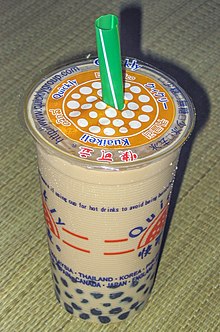Bubble tea

Bubble tea is a tea beverage mixture with milk and balls of tapioca. Originating in Taiwan, bubble tea is especially popular in Asian countries such as the People's Republic of China, Hong Kong, South Korea, Malaysia, the Philippines, and Singapore. The drink is also popular in Europe, Canada, and the United States.
Definition
Bubble tea consists of a mixture of iced or hot sweetened tea, milk, and possibly other flavorings. The beverage is shaken, producing the small bubbles characteristic of the name. Black gummy balls made of tapioca, called "pearls," sit at the bottom of the cup. The pearls, much larger than those found in tapioca pudding, have a diameter of at least 6 millimeters, but smaller balls are occasionally used. The pearls are sucked through a wide straw along with the drink, providing something to chew on between sips.
When ordering, customers are often asked whether they want "boba" or "pearls" in their beverages, and both terms refer to the tapioca balls. An hour is required to prepare the tapioca, and in the preparation and cooking of the tapioca, the pearls expand considerably. After this period, the tapioca is drained from the water, poured into a sugar and water solution, and are ready to use.
Another alternative to the traditional tapioca balls is coconut jelly, a lighter option. Coconut jelly is served in small Lego-like pieces and has a sweet, crunchy consistency. They add a new dimension to bubble tea and are often ordered "half and half," meaning half pearls and half coconut jelly.
The recipes for bubble tea vary, but flavoring is usually added to hot black or green tea, which is shaken in a cocktail shaker or mixed in blender with ice until chilled. The mixture is usually combined with milk and softened tapioca pearls. Most cafes that serve bubble tea also use a machine to seal to the top of the cup with a plastic cellophane, which a drinker pierces with a straw.
Some cafes use a nondairy milk substitute to replace milk; the substitute adds a distinct flavor and consistency to the final product. The possible reason for a nondairy milk substitute is the lactose intolerance of many Asian people.
The flavorings added to bubble tea are usually fruity and can be powders, fruit juice, pulp, or syrups. Sellers sometimes differentiate between bubble tea made with fruit pulp, juice, and pearls; and green, black, or brown milk teas.
Bubble tea can also refer to hot Hong Kong-style milk tea with tapioca balls.
Origin

Bubble tea supposedly originated in Taichung, Taiwan during the early 1980s. A Taiwanese tea shop named Chun Shui Tang (春水堂) experimented with cold milk tea by adding fruit, syrup, candied yams and, finally, tapioca balls. Although the drink was not popular at first, publicity from a Japanese television show caused businessmen to take notice, and the drink became well known throughout Asia in the 1990s.
In the late 1990s, bubble tea began to gain popularity in the United States and Canada. This unique beverage also received some attention in the American mainstream media, including Morning Edition on National Public Radio and the Los Angeles Times. Bubble tea can also be found in major European cities, such as London and Paris. Bubble tea has spread internationally, mainly through overseas Chinese communities.
Names
Bubble tea is known under a variety of other names, including:
- black pearl tea
- black pearl ice tea
- boba drink
- 波霸奶茶 bōbà nǎichá — literally "large breast" milk tea.
- boba milk tea (Chinese: 波霸奶茶; pinyin: bōbà nǎichá)
- bubble milk tea
- milk pearl tea
- 奶茶 naicha — literally, "milk tea"
- pearl ice tea
- pearl milk tea (珍珠奶茶; zhēnzhū nǎichá)
- pearl sago [milk] tea — in English only; usually used for canned varieties where pearl sago (西米; xīmǐ; Cantonese: sai1 mai5) is used instead of tapioca.
- pearl tea
- ชาไข่มุก, ชามุก literally, pearl tea
- QQ drinks — kiú is Taiwanese slang for "chewy"
- tapioca drink
- tapioca tea
- trà trân châu (equivalent to 茶珍珠, literally "pearl tea") (Vietnamese)
- 珍珠奶茶 zhēnzhū nǎichá (Putonghua, Taiwanese and overseas Chinese usage) — literally, "pearl milk tea"
In southern Taiwan, pearl milk tea with large pearls are usually called "boba milk tea", while those with small pearls are called "pearl milk tea".
Availability
Bubble tea is available at small dedicated boba cafes and some restaurants. Most bubble tea stores serve a variety of drinks, including coffee, juices, and fruit freezes, which are sometimes also called bubble tea, even though they do not contain any tea ingredients. These drinks can include flavors which are less familiar to non-Asians, such as taro, honeydew, or lychee—as well as the familiar chocolate, Ovaltine, or strawberry—and may be available with or without tapioca pearls. Hot versions with tapioca pearls can also be found.
Trivia
In September 2004, while defending a US$18 billion weapon purchase plan, the ROC Ministry of National Defense used bubble tea as an example of the overall cost of the proposed purchase. The Ministry stated that the total cost of the weapons systems would be equivalent to the money saved if all Taiwanese drank one fewer pearl milk tea per week for a period of twenty years.
